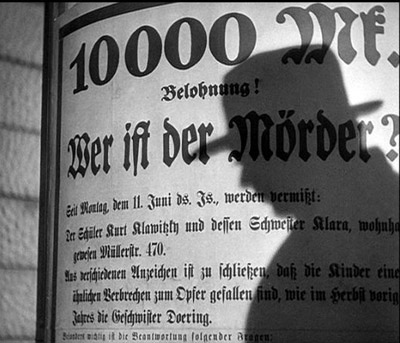
 Who is M?
Who is M?M
The movie “M,” directed by Fritz Lang, is considered to be the turning point in our film course. This movie basically sums up everything that we have learnt thus far. In the first ten minutes of the film, we are able to decipher certain elements that we have learnt.
Each shot is there for a reason, and it plays an important role to the bigger picture.
Firstly, the narrative structure can be seen as expressionistic. In the first few minutes, when Elsie Beckman comes back from school, she carries a ball and is seen bouncing it off the ground and catching it. She throws the ball into the air and catches it. The ball is seen bouncing off a poster. The camera then focuses on the poster, which was like a reward sign to catch a murderer. This shot has two angles from which we can analyze from. Firstly, it can be seen as the audience looking at the poster from Elsie’s perspective, as she is the one playing with the ball. The second is the presence of the poster, prepares the audience psychologically for what is about to come. When we see it, we know that something bad is going to happen. Then, we see the first appearance of M. He is depicted as a mysterious figure because we first see him as a shadow that overshadows the poster. This shot can be said to arouse the audience’s curiosity, because it is at that moment we start to question “Who is M?”
Secondly, the miss-en-scene of the first ten minutes of the movie was carefully edited and planned out. When Elsie’s mother calls her, there is a series of shots, starting from the empty staircase, to the empty space with the laundry lines hanging, to little Elsie’s empty chair and the table left untouched, to the rolling ball on the ground, and finally, the balloon “person” clinging to the telegraph wires. The series of shots were like a storytelling sequence. Fritz Lang was able to tell what happened to little Elsie, and the emotions her mother had with just a few simple shots of pictures without sound; except for the voice of her mother calling “ Elise, Elise!” The empty staircase signified and amplified her mother’s feeling of emptiness that her child was not at home. The empty chair signified the absence of Elise’s presence, and if we linger at that shot, we realize that untouched table and chair seem to give off a depressed and sad kind of feeling. The rolling of the ball on the ground indicates that something happened to Elsie. The movement of the ball rolling indicates that she was grabbed. The last shot, especially, signified that little Elsie would never return home to her mother. The balloon fluttering in the wind can be assumed to indicate that all is still and silent.
Thirdly, there is a balance of sound and silence in the first ten minutes of the movie. The use of silence is there for a reason. It is there, to give depth to the scene and create the tension and anticipation that the audience would experience. There is the use of silence, when the mother is cooking and looks at the clock, or the scene where the mother is preparing supper and setting the table; then, looks at the clock again. The silence is there to create the suspense of what happen to little Elsie. The use of silence can be seen again at the end of the last two shots. The first of was when the ball was rolling on the ground and the last shot was the balloon “person” clinging to the telegraph wires. The silence indicates the horrible end that has happened to Elsie. The silence is there to emphasize the mystery of the murder, as in, what exactly happen to Elsie Beckman? Secondly, we do not know the identity of the murderer. In relation to that, the use of sound is an important element that is displayed in this movie. Although the murderer is depicted as a mysterious figure, and his identity is unknown, his whistling becomes an important clue. The whistling is a motif in the plot of the story. Besides that, simultaneously, as we see the series of shots at the end, telling the story of little Elsie’s death, we hear nothing except for the sound of her mother calling her “Elsie! Elsie!” The sound of her mother’s voice indicates the emptiness of her child not being present. It conveys the emotions of a worried mother, wondering what has happened to her child. This adds depth to the miss-en-scene.
In conclusion, there is a purpose to everything that is displayed on films. This course has shown us to not only watch things and rationalize on the surface, but rather, to look deeper within the pieces of films that we watch and realize that there is more to things that meets the eye.